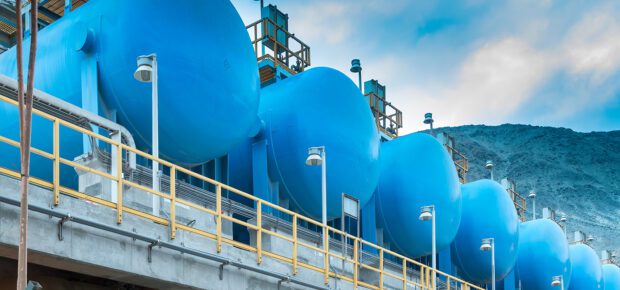January 28, 2025
Large parts of the world face a tough challenge: their populations are growing, and they need to find a way to provide water for them. Desalination, removing salt from seawater or salty groundwater, is the main source of drinking water for many countries. In many places, it is seen as a last resort because of high electricity costs. The energy required to operate a desalination plant often reduces the feasibility of those projects, especially when compared to other strategies.
The plummeting cost of renewable energy is changing those calculations.
“Desalination technology holds great promise for addressing global water scarcity and improving sanitation through several key advancements,” said IEEE Member Rafel Muniz. “Researchers are making strides in developing more energy-efficient desalination processes to cut down on overall energy consumption. By treating various types of impure water beyond just seawater, desalination can become more versatile and applicable in diverse regions.”
Desalination is Energy-Intensive
Water treatment plants are usually situated in places that take advantage of the natural flow of water. These site selection choices help lower the costs associated with pumping the water to the facility and to businesses and households that will use it.
Desalination plants don’t have that luxury. By their nature, they are usually located at sea level, and just about everything flows toward the sea. They need to pump water from the ocean and pump it out of the facility to the end user.
Plants rely on constant electricity to produce pressurized flows through the reverse osmosis membranes that filter salt from water. Energy often accounts for 36% of a desalination plant’s operating budget, according to the U.S. Department of Energy.
Using Renewables to Power Desalination
As renewable energy becomes less expensive, engineers face the question of how to use it smartly. Once the infrastructure is in place, renewable energy is inexpensive. But renewable energy sources aren’t always available: the sun doesn’t shine, and wind doesn’t blow at the same time people need power. Sometimes, there’s a surplus when demand is low; at other times, there might not be enough energy to meet everyone’s needs.
A recent study in the IEEE Journal of Modern Power Systems and Clean Energy explores this issue in depth, focusing on regions that rely on traditional power plants and renewable sources for electricity and desalination plants for water. When there’s more renewable energy than immediate demand, should we invest in batteries to store surplus electricity for later, or use that extra energy to produce and store freshwater in large tanks?
The study’s findings show that the ideal solution depends on the specific circumstances. Both batteries and tanks can help reduce costs by shifting energy use from busy times of day to quieter times. Generally, freshwater tanks cost less to implement than large arrays of batteries. However, batteries have the advantage of flexibility since they can supply electricity for any purpose, not just for producing freshwater.
In regions that are still partly reliant on renewable energy, building freshwater tanks often proves more cost-effective. But as the share of renewable energy grows, tanks and batteries become increasingly valuable tools for balancing supply and demand.
“To scale up these technologies effectively, it is essential to navigate crucial transformation stages and foster dialogue between developers, industry, government and civil society,” said IEEE Member Suélia Fleury. “True progress will come when all stakeholders collaborate, prioritizing the environment and human well-being in harmony.”





 Meaningful Momentum or Running in Place?
Meaningful Momentum or Running in Place? AI Through Our Ages
AI Through Our Ages Liquid Infrastructure: Our Planet's Most Precious Resource
Liquid Infrastructure: Our Planet's Most Precious Resource The Impact of Technology in 2025
The Impact of Technology in 2025 Quantum and AI: Safeguards or Threats to Cybersecurity?
Quantum and AI: Safeguards or Threats to Cybersecurity? Why AI Can't Live Without Us
Why AI Can't Live Without Us Bits, Bytes, Buildings and Bridges: Digital-Driven Infrastructure
Bits, Bytes, Buildings and Bridges: Digital-Driven Infrastructure Impact of Technology in 2024
Impact of Technology in 2024 Emerging AI Cybersecurity Challenges and Solutions
Emerging AI Cybersecurity Challenges and Solutions The Skies are Unlimited
The Skies are Unlimited Smart Cities 2030: How Tech is Reshaping Urbanscapes
Smart Cities 2030: How Tech is Reshaping Urbanscapes Impact of Technology 2023
Impact of Technology 2023 Cybersecurity for Life-Changing Innovations
Cybersecurity for Life-Changing Innovations Smarter Wearables Healthier Life
Smarter Wearables Healthier Life Infrastructure In Motion
Infrastructure In Motion The Impact of Tech in 2022 and Beyond
The Impact of Tech in 2022 and Beyond Cybersecurity, Technology and Protecting Our World
Cybersecurity, Technology and Protecting Our World How Technology Helps us Understand Our Health and Wellness
How Technology Helps us Understand Our Health and Wellness The Resilience of Humanity
The Resilience of Humanity Harnessing and Sustaining our Natural Resources
Harnessing and Sustaining our Natural Resources Creating Healthy Spaces Through Technology
Creating Healthy Spaces Through Technology Exceptional Infrastructure Challenges, Technology and Humanity
Exceptional Infrastructure Challenges, Technology and Humanity The Global Impact of IEEE's 802 Standards
The Global Impact of IEEE's 802 Standards Scenes of our Cyber Lives: The Security Threats and Technology Solutions Protecting Us
Scenes of our Cyber Lives: The Security Threats and Technology Solutions Protecting Us How Millennial Parents are Embracing Health and Wellness Technologies for Their Generation Alpha Kids
How Millennial Parents are Embracing Health and Wellness Technologies for Their Generation Alpha Kids Space Exploration, Technology and Our Lives
Space Exploration, Technology and Our Lives Global Innovation and the Environment
Global Innovation and the Environment How Technology, Privacy and Security are Changing Each Other (And Us)
How Technology, Privacy and Security are Changing Each Other (And Us) Find us in booth 31506, LVCC South Hall 3 and experience the Technology Moon Walk
Find us in booth 31506, LVCC South Hall 3 and experience the Technology Moon Walk Virtual and Mixed Reality
Virtual and Mixed Reality How Robots are Improving our Health
How Robots are Improving our Health IEEE Experts and the Robots They are Teaching
IEEE Experts and the Robots They are Teaching See how millennial parents around the world see AI impacting the lives of their tech-infused offspring
See how millennial parents around the world see AI impacting the lives of their tech-infused offspring Take the journey from farm to table and learn how IoT will help us reach the rising demand for food production
Take the journey from farm to table and learn how IoT will help us reach the rising demand for food production Watch technical experts discuss the latest cyber threats
Watch technical experts discuss the latest cyber threats Explore how researchers, teachers, explorers, healthcare and medical professionals use immersive technologies
Explore how researchers, teachers, explorers, healthcare and medical professionals use immersive technologies Follow the timeline to see how Generation AI will be impacted by technology
Follow the timeline to see how Generation AI will be impacted by technology Learn how your IoT data can be used by experiencing a day in a connected life
Learn how your IoT data can be used by experiencing a day in a connected life Listen to technical experts discuss the biggest security threats today
Listen to technical experts discuss the biggest security threats today See how tech has influenced and evolved with the Games
See how tech has influenced and evolved with the Games Enter our virtual home to explore the IoT (Internet of Things) technologies
Enter our virtual home to explore the IoT (Internet of Things) technologies Explore an interactive map showcasing exciting innovations in robotics
Explore an interactive map showcasing exciting innovations in robotics Interactively explore A.I. in recent Hollywood movies
Interactively explore A.I. in recent Hollywood movies Get immersed in technologies that will improve patients' lives
Get immersed in technologies that will improve patients' lives